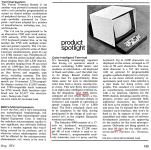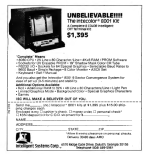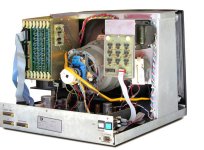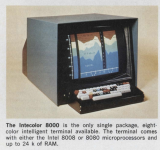voidstar78
Veteran Member
I was searching old Datamation issues for the earliest mention of the Q1 Corporation microcomputer.
The first mention of the use of the Intel 8008 that I could find is Dec. 1973 in the "A-100A Datacumulator" device). This is not to say that was the first system to use the 8008, but from the perspective of Datamation (that focused on "dp" dataprocessing system), that is where an article first mentions the Intel 8008.
The 8008 is then mentioned briefly a month later, Jan. 1974 issue, on page 18.
The March 1974 issue wasn't available to me.
Then, in May 1974 issue, I came across the following "Color Intelligent Terminal" (4K RAM, but not clear how it was programmable -- like the Datapoint 2200 and SOL-20, they used the term "intelligent terminal" to mean programmable). Interesting to me that it was 80x25 text and also had a "plot mode for doing curves" so unclear how much of a graphics mode that was, but it also supported "eight-color" terminal.
While it states a price and 90-day waiting period, does anyone know if any were actually built? Looks like it was. The following article also lists the 8 colors that were available.
"THE APPLICATION OF THE INTERCOLOR 8000 TERMINAL TO THEMATIC CARTOGRAPHY" (used by University of Tennessee)
Neat stuff. I'm not sure how it was programmed (similar to the original Datapoint 2200 -- I recall reading CTC used some "larger" HP system to do the initial programming that was then loaded on the tape).

And, by the way, I did finally come across a Q1 Corporation advertisement. The earliest ad I could find was in the October 1977 issue (page 161). It is a very simple ad that is repeated in a few subsequent issues, which has no image and simply just says:
"Q1 Corporation the first company to develop, manufacture and market microcomputer systems has now introduced the Q1/Lite, the ultimate office machine"
Then list Hauppauge, New York 11787 and a couple contact phone numbers.
So, I'm still a little suspect about Q1's 1972 claim. Even if it was actually 1973 or 1974, I'd still want to see an actual price before declaring it a commercial product.
The first mention of the use of the Intel 8008 that I could find is Dec. 1973 in the "A-100A Datacumulator" device). This is not to say that was the first system to use the 8008, but from the perspective of Datamation (that focused on "dp" dataprocessing system), that is where an article first mentions the Intel 8008.
The 8008 is then mentioned briefly a month later, Jan. 1974 issue, on page 18.
The March 1974 issue wasn't available to me.
Then, in May 1974 issue, I came across the following "Color Intelligent Terminal" (4K RAM, but not clear how it was programmable -- like the Datapoint 2200 and SOL-20, they used the term "intelligent terminal" to mean programmable). Interesting to me that it was 80x25 text and also had a "plot mode for doing curves" so unclear how much of a graphics mode that was, but it also supported "eight-color" terminal.
While it states a price and 90-day waiting period, does anyone know if any were actually built? Looks like it was. The following article also lists the 8 colors that were available.
"THE APPLICATION OF THE INTERCOLOR 8000 TERMINAL TO THEMATIC CARTOGRAPHY" (used by University of Tennessee)
Neat stuff. I'm not sure how it was programmed (similar to the original Datapoint 2200 -- I recall reading CTC used some "larger" HP system to do the initial programming that was then loaded on the tape).

And, by the way, I did finally come across a Q1 Corporation advertisement. The earliest ad I could find was in the October 1977 issue (page 161). It is a very simple ad that is repeated in a few subsequent issues, which has no image and simply just says:
"Q1 Corporation the first company to develop, manufacture and market microcomputer systems has now introduced the Q1/Lite, the ultimate office machine"
Then list Hauppauge, New York 11787 and a couple contact phone numbers.
So, I'm still a little suspect about Q1's 1972 claim. Even if it was actually 1973 or 1974, I'd still want to see an actual price before declaring it a commercial product.




